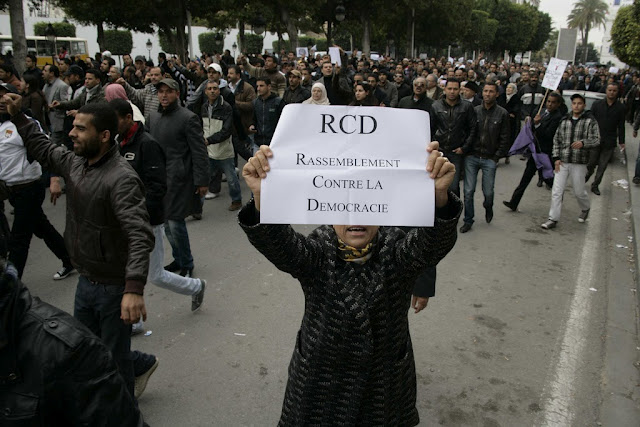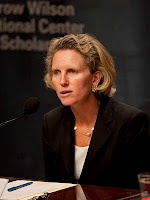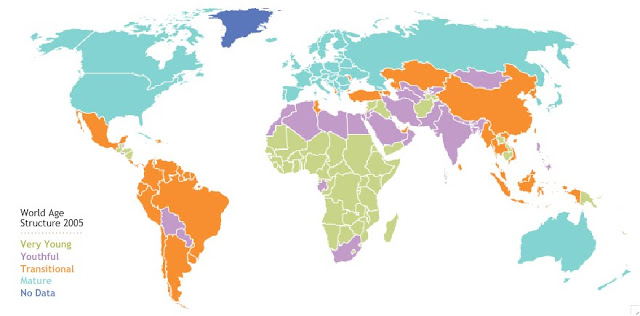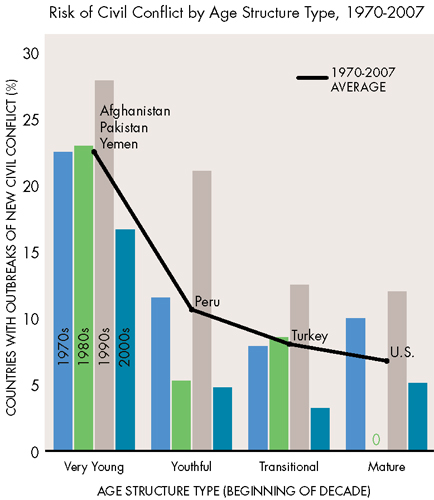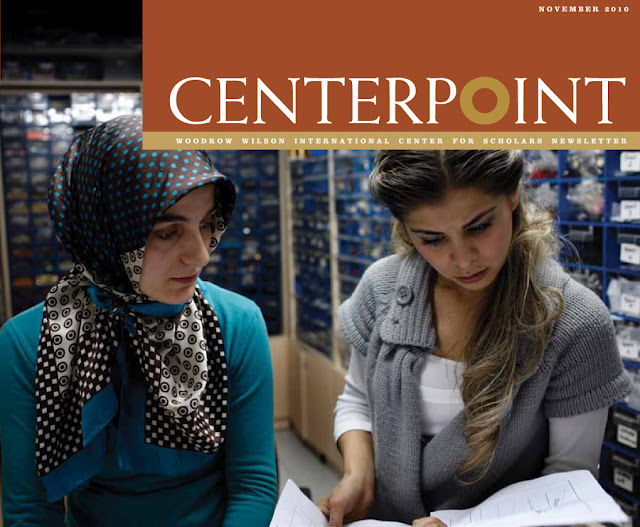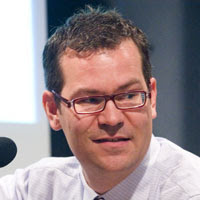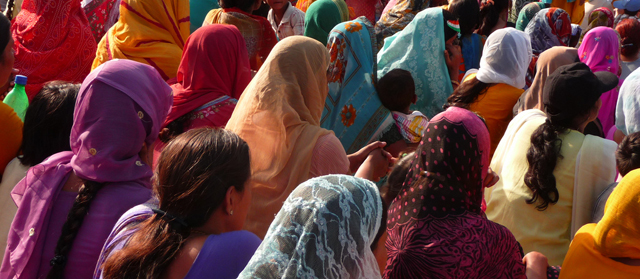-
The Age of Revolution? Demography Experts Comment on Tunisia’s Shot at Democracy
›January 28, 2011 // By Schuyler NullAs unrest continues across several Middle Eastern countries, analysts are scrambling to explain the “arc of revolution.” Richard Cincotta’s recent post on the “Jasmine Revolution” predicts a relatively high chance of Tunisia attaining liberal democracy, based on demographic factors and long-term trends, and it’s drawn some well-thought out and provocative feedback from fellow demographers Elizabeth Leahy Madsen, Jack Goldstone, and Jennifer Sciubba.
Elizabeth Leahy Madsen is a senior research associate at Population Action International and author of The Shape of Things to Come: Why Age Structure Matters to a Safer, More Equitable World:I have two questions. First, have you shifted to a new definition of age structures (intermediate, etc.) based on median population age? In the past, you and other demographic security researchers have measured age structure as the relative proportion of different age groups within the population, either the total population, total adult population, or working-age population. Why did you select median population age for this analysis? A quick review of the figures available on the UN Population Division’s website shows that the relative size of the 15-24 age group within Tunisia’s total population has been vacillating within the range of 19-21 percent since 1975. In 2005, that “youth bulge” was 21 percent, the highest since 1980, but there has been a rapid decline to 19 percent by 2010.
Jack A. Goldstone is the director of the Global Policy Center at George Mason University and author of a number of books on social movements, revolutions, and international politics:
As you say, no matter how age structure is measured, Tunisia is much further through the demographic transition than other countries in the Arab world. I would like to see this highlighted more in media coverage of the revolution, particularly in accounts of similar attempts to provoke uprisings that have taken place in Algeria, Egypt, and Yemen in recent weeks. From a demographic perspective, those attempts are less likely to achieve success (except possibly in Algeria, based on your map).
My second question is for further elaboration on the steps that lead from a dissipating youth bulge to a greater likelihood of attaining democracy (leaving aside the also-difficult question of sustainability). If I understand your description of the mechanisms at work, in an authoritarian regime with a youth bulge, the government is able to keep its hold on power because the presence of a youth bulge either creates volatility or the threat of volatility in the eyes of the commercial elites whose support is critical to the regime. Does this support exist even in situations where volatility is rare, in which case the large youthful population is manipulated or whitewashed by the regime as a threat to stability? Then, as the age structure matures and becomes less youthful, the regime can no longer invoke youth (directly or indirectly) as a danger, and therefore support for the regime from the elites erodes?
You don’t specifically mention economic conditions in Tunisia, apart from Ben Ali’s resource hoarding, but issues such as unemployment rates have been frequently highlighted in media accounts of the revolution. In addition to the unpredictable triggers such as the self-immolation in Tunisia’s case, do deeper-seated structural problems such as high unemployment and/or rampant corruption have to be extant to provoke revolution in an authoritarian context? Or is the dissolution of a youthful age structure combined with an unpredictable trigger sufficient?Richard’s insights into Tunisia’s prospects for democracy are terrific and I agree with him. However, in regard to the causes of the rebellion, I have to disagree with him in one respect – Tunisia in 2010 is very much a youth bulge country, at least as far as political theory would see it. As Henrik Urdal has shown, youth bulge should not be measured as the size of the youth cohort (15-24) against the entire population, but as the fraction of youth in the adult population (those aged 15 and older). The 0-14 group is politically not relevant, and should not be counted in assessing the impact of youth cohorts on the total population’s political mobilization potential.
Jennifer Sciubba is a Mellon Environmental Fellow at Rhodes College and the author of The Future Faces of War: Population and National Security:
For Tunisia, median age may in fact be misleading (as I didn’t realize until I looked at the age pyramids that Richard has posted). Because birth rates fell very rapidly after 1995, median age in 2010 is intermediate, but if you look only at the population aged 15 and up, you still see very large cohorts of youth compared to total adults.
Because Tunisia’s birth rate only started falling sharply after 1995, the large cohorts born in 1986-1995 – now age 15-24 – still make up a very large portion (33 percent) of all adults. While the next cohorts are much smaller, meaning this youth bulge will soon fade, it is still very much present, as Richard’s graphs show.
There is no automatic link between a certain age structure and political rebellion, but the combination of a large youth bulge and economic frustration among youth is a potent force for political instability. That combination is certainly one feature of Tunisia in 2010, although the extreme corruption of the Ben Ali regime and his family was a galling and critical factor in the widespread rejection of his regime.
That points to another bit of misleading data. Many (including me) assumed that because Tunisia’s recent economic growth was strong, at five percent per year, economic grievances could not be so widespread. But that is wrong, because we did not appreciate how much of that growth has been grabbed by Ben Ali’s family (which according to one account had ownership interests in half the businesses in the country) and cronies. Substantial growth from which many have been excluded – especially youth – is in fact a reason for widespread grievances, and that was another key factor behind the mass protests.Like Jack and Liz note, using median age helps us understand Tunisia’s progress along the demographic transition, but it doesn’t really help us understand the protests in Tunisia or in other countries across the “arc of revolution.” Median age obscures the individual experiences of young adults who are putting their lives at risk to speak out in protest or setting themselves on fire in desperation. As Jack points out, from a theoretical point of view, Tunisia is very much experiencing cohort crowding – whether we call it “youth bulge” or “early worker bulge” the outcome is the same. To say that Tunisia is not a youth bulge country misses the point.
Cincotta has promised a reply to the comments is forthcoming, which we can forgive him, frankly, given the length and complexity of these great responses.
Part of the reason we political demographers buy into the link between youth bulge and conflict is the idea of cohort crowding. As Richard Easterlin points out, a cohort’s economic and social prospects tend to have an inverse relationship to the cohort’s size relative to those around it, other things being constant. In Tunisia’s case, those between ages 25-35 are part of a larger cohort than those preceding ones so they are crowded out of the labor market and will tend to have lower relative income compared to preceding generations, which are smaller.
As I note in my book, one study of Tunisians looking for work reported that young adults felt crowded out of benefits in the family, school, and labor markets. In particular, according to a study by M. Bedoui and G. Ridha:“…family and marital problems were common. They became poorer, lost confidence, and became fatalistic and submissive. Over the long run the majority saw unemployment as a source of disequilibrium, humiliation, and even oppression.” (in Hilary Silver, “Social Exclusion: Comparative Analysis of Europe and Middle East Youth,” Middle East Youth Initiative Working Paper p. 30.)
That quotation seems eerily prescient in Tunisia’s case. Mohamed Bouazizi certainly seemed to succumb to fatalism, and the protests started as economic but quickly moved to political. Political, social, and economic marginalization are connected. While there is some diversity in age structure across the Middle East, the populations of those aged 15-24 in Egypt, Lebanon, Tunisia, Jordan, Algeria and Iran, which experienced youth protests in 2009, are all between 27 and 34 percent of all adults ages 15-59, with Lebanon and Tunisia at the lower end of the spectrum and Egypt and Jordan at the higher. As we can see from the population pyramid of each of these states, there is a clear population bulge at these ages.
We also have to think about the cohort effect. The cohort effect describes shared historical experiences of particular age groups. Across the “arc of revolution,” young adults are plugged into Facebook, Twitter, and other internet forums to share experiences of marginalization and revolution. This likely informs their choice of whether or not to speak out.
Sources: Huffington Post, Middle East Youth Initiative, The New York Times, Telegraph.
Photo Credit: “055,” courtesy of flickr user Nasser Nouri. -
Tunisia’s Shot at Democracy: What Demographics and Recent History Tell Us
›January 25, 2011 // By Richard Cincotta
While events in Tunisia, beginning mid-December and leading ultimately to President Ben Ali’s departure within a month, have rocked the Arab world, they leave an open question: Will Tunisia’s “Jasmine Revolution” ultimately lead to the Arab world’s first liberal democracy? [Video Below]
-
Paradise Beneath Her Feet: How Women Are Transforming the Middle East
›Isobel Coleman, senior fellow for U.S. foreign policy at the Council on Foreign Relations, said she believes demographic changes are intensifying the notion that women’s empowerment is key to the growth and prosperity of the economies of Arab and Muslim-majority countries.
Coleman, author of the book Paradise Beneath Her Feet: How Women Are Transforming the Middle East, spoke at the Wilson Center in October, with Haleh Esfandiari moderating.
In addition to the Middle East’s demographics, Coleman also discussed how women in these traditional societies face challenges expanding their roles because women’s rights are often seen in a negative light. Coleman noted that things are changing, however, because women in the Muslim world are turning towards an Islamic discourse, which allows them to expand their rights within society’s religious framework. With this tactical shift and gradual gains in education, Coleman explained how women are slowly yet steadily transforming their societies.
Coleman began her talk by focusing on the demographic changes in the region, noting that 50 percent of the Arab world’s population is under the age of 22. Furthermore, education was once the exclusive preserve of men in many Arab and Muslim states (in some cases, only decades ago). Today, however, women often constitute the majority of those enrolled in these countries’ educational institutions: Females outnumber males in Jordan’s secondary schools and constitute 70 percent of all university students in Iran. While the levels of educational attainment and achievement among women are increasing, normative and legal restrictions on their socioeconomic mobility remain. Coleman indicated that this contradictory scenario has led to greater opposition to impediments to women’s equality.
Coleman went on to address the tactics being used by the latest generation of reform-minded women in the Muslim world. She said today’s reformist women are more cognizant of the religious conservatism in their societies and are taking on religion in a way earlier feminists did not. By making feminist arguments from an Islamic perspective they avoid being “slandered” by conservatives and traditionalists as pro-Western or anti-Islamic. Coleman noted that some women adopt such a stance out of deep religious conviction, while others do it in the name of expediency. She indicated this new strategy of compromise has given more women influence in social affairs and led to significant engagement with governments.
With the advent of new social media and technology, women have become more visible and able to express their opinions about previously taboo gender-related issues. Female journalists and bloggers are more stridently supporting feminist discourses. Coleman mentioned Sweet Talk, the Arabic language equivalent of the American television show, The View, on which the female co-hosts have addressed topics such as polygamy, rape, incest, and the Saudi prohibition on women driving.
According to Coleman, these factors of change – demographic transitions, the role of media, and an awareness of growing extremism in society – are contributing to women making strides in the region and a “wearing away” of gender inequality in the Muslim world. Given the gains women have made so far, Coleman said she is “cautiously optimistic” for the future.
Luke Hagberg is an intern with the Middle East Program at the Wilson Center; Haleh Esfandiari is the director of the Middle East Program.
Photo Credit: Yemeni women in computer class, courtesy of flickr user World Bank Photo Collection, and David Hawxhurt/Wilson Center. -
Demographic Security Comes to the Hill
›December 16, 2010 // By Hannah Marqusee“We are now in an unprecedented era of demographic divergence,” said Population Action International’s Elizabeth Leahy Madsen at a September briefing held by Congressman John Tierney’s Subcommittee on National Security and Foreign Affairs and Congressman Russ Carnahan’s Subcommittee on International Organizations, Human Rights and Oversight.
Eighty percent of the world’s conflicts occur in places where 60 percent or more of the population is under 30, and 90 percent of countries with young populations have weak governments, said Chairman Tierney in his opening remarks. He said that while such demographic trends “appear to be issues for the future…it is important that we start this dialogue today, so that we can make steps to address [them].” ECSP Director Geoff Dabelko and the Stimson Center’s Richard Cincotta joined Madsen on the panel titled, “The Effects of Demographic Change on Global Security,” at the Capitol Visitor Center.
Youth Bulges and National Security
The countries of greatest security threat to the United States are also those with the youngest age structures and rapidly increasing populations, said Madsen. By next year, the world’s population will have reached seven billion, with 95 percent of that growth occurring in the developing world.
Large youthful populations can be a source of national strength because they provide innovation and manpower, said Dabelko, but without significant investment they may also contribute to state instability. When there are often few opportunities to obtain a job or an education for young people, there are low “opportunity costs” to joining a rebel group, said Madsen.
State instability can be affected by youth bulges, shifting religious or ethnic compositions, or food and water insecurity, but age-structural transitions are the strongest indicator of state performance, said Cincotta. Despite conventional wisdom, there is actually little evidence to link state failure with premature adult mortality due to AIDS or a high male-to-female ratio, he added.
It is not only developing countries with high fertility rates that face demographic difficulties, Cincotta noted. Countries such as Japan and Germany will soon have reached a “post-mature” age structure in which their aging populations and comparatively small workforces will tax state institutions and threaten economic stability.
Population Policies: Using “Soft Tools” to Improve National Security
Recently, leaders in the U.S. government have been paying increased attention to the linkages between demography and security through the “three Ds:” diplomacy, development, and defense. In 2008, the National Intelligence Council’s Global Trends 2025 included demographic assessments to analyze security trends, and this year, the National Security Strategy featured demographic trends along with the environment and other non-traditional areas.
Dabelko said that while this growing recognition signals progress, the “hard tools” of the traditional security community must be bolstered with “soft tools” commonly used by the international aid community, such as female empowerment, education, health services and youth employment.
Madsen argued that empowering the 215 million women with an unmet need for family planning worldwide through increased funding for voluntary family planning programs is a cost-effective way to shape population trends and ultimately reduce security threats.
“Demography is not destiny,” said Madsen. “Family planning has been an unsung signature of U.S. foreign assistance for decades.”
Similarly, Cincotta said that policies should help states transition out of youth bulges, and help countries with aging populations reform social institutions to protect older people.
Dabelko added that while progress has been made in acknowledging the linked nature of population trends and national security, there is significant room for improvement. Pointing to the successes of integrated population, health, and environment (PHE) programs, which provide environmental conservation and family planning services simultaneously, he called for similar programs to address population dynamics and conflict prevention. Long-term solutions call for coordinated resources and integrated strategies, he said.
Read the speakers’ full remarks: Chairman John F. Tierney, Richard Cincotta, Geoff Dabelko, and Elizabeth Leahy Madson (slides).
Sources: Guttmacher Institute, Population Action International, National Intelligence Council.
Image Credits: “World Age Structure 2005” and “Risk of Civil Conflict by Age Structure Type, 1970-2007,” courtesy of Population Action International. -
Empowering Women in the Muslim World
›December 2, 2010 // By Wilson Center StaffOriginally featured in the Wilson Center’s Centerpoint, November 2010.
For decades, women in the Middle East have actively struggled for equal status before the laws of their respective countries. They have strived to attain equal participation in politics and society, and progressive justice throughout the region. While they have made progress in some parts of the region, many challenges remain. The Wilson Center’s Middle East Program recently held three meetings to discuss challenges as well as progress to empowering women across the Muslim world.
A Modern Narrative
The American Islamic Congress (AIC) recently published a report, “A Modern Narrative for Muslim Women in the Middle East: Forging a New Future,” that highlights past and present triumphs and difficulties – economic, legal, political, religious, and social –for women’s rights throughout the region. On September 30, the Middle East Program co-sponsored a meeting with the AIC to review the status of women in Saudi Arabia and Jordan, based on findings in the AIC’s report.
Fawziah Al-Hani, manager of the Gherass Center for Social Education in Saudi Arabia, expressed frustration about the progress women have made in her native Saudi Arabia. She said women there are perceived as second-class citizens by the country’s legal, economic, political, religious, and social institutions. Women’s issues are rarely discussed in Saudi political and social spheres, and women are not represented in government or the business sector. She said if women are allowed to be active outside the home, they are mostly restricted to educational and health activities.
While she is frustrated about these restrictive Saudi policies toward women, Al-Hani said she maintains hope, as changes take place within the society and government through new initiatives and movements.
Rana Husseini, a human rights activist, author, and journalist, detailed the changes to the status of women in Jordan over the past 20 years. Husseini, whose human rights activities over the past two decades in Jordan have focused on honor crimes and other women’s issues, said Jordan has made substantial progress on women’s rights as a result of intense media and civil society activism. While there is room for improvement, she said women are now participating in government and significant reforms have been made to the judicial system.
Though the effectiveness of quotas for women in government may be debated, Husseini noted that quotas facilitate women’s participation in elections and government service. In fact, she said, there are some 50 women judges in Jordan. She noted that honor killings, except in extreme cases, are becoming rarer, and harsher sentences are being imposed for honor crimes.
With constant pressure on the government and society, reforms will continue, said Husseini, who is optimistic about the future for women rights in Jordan and in the Middle East as a whole.
Demographic Realities
Why do many Middle Eastern women not enjoy the same economic opportunities as women of other regions? Can they be empowered to participate at a greater level? Nadereh Chamlou, a senior adviser at the World Bank, attributed the gender inequality to restrictive social norms. She said the region’s women must be empowered to participate in a more significant way if their countries are to effectively exploit, instead of squander, the current economic “window of opportunity.”
At a September 13 discussion, Chamlou said the good demographic news is that there are high numbers of working-age people and thus the potential for rapid economic growth. However, Middle Eastern countries have the highest dependency rates in the world, a fact that Chamlou attributed to the low economic participation of Middle Eastern women relative to female citizens’ participation in other parts of the world. This reality means the Middle East’s demographic composition will not be exploited to its full potential.
Increasing economic opportunities for women will require changing social norms, said Chamlou. She cited a study conducted by the World Bank in three Middle Eastern capitals – Amman, Jordan; Cairo, Egypt; and Sana’a, Yemen – that revealed the biggest reason for the poor representation of women in the workforce is the negative male attitude regarding women working outside the home. Notably, social norms and such negative male attitudes proved to restrict women’s participation far more than the need to attend to child-rearing duties. Despite the successful efforts of most Middle Eastern states to improve education opportunities, conservative social norms still pose a barrier to female empowerment.
Some simple changes could have a substantial impact. Chamlou recommended focusing on educated, middle-class women, undertaking more efforts to bring married women into the workforce, and emphasizing changing attitudes – particularly among conservative younger men – toward women working outside the home.
Lessons from Tunisia
In Tunisia, the progress of women’s empowerment can serve as a model for the region, noted women’s rights advocate Nabiha Gueddana, president and director-general of the National Agency for Family and Population in Tunisia.
Speaking at a September 8 meeting, Gueddana said the Arab world can learn much from her native Tunisia regarding the positive effects of empowering women. Gueddana, also a candidate for undersecretary-general of UN Women at the United Nations, described how Tunisian women have been empowered politically, economically, and socially, and how this empowerment has benefited Tunisian society.
Tunisia has undergone substantial changes since achieving independence from France in 1956. Tunisian women had second-class status in the years prior, a time Gueddana described as one that relegated them to a life of constant child-rearing, illiteracy, and economic dependence.
Yet Tunisia has become a beacon for other Muslim societies: the country’s labor code allows full female participation in the economy and education is open equally to boys and girls. Family planning programs and important strides in health have considerably lowered the birth rate and lengthened the life expectancy of the average woman. Gueddana also noted that Tunisia’s economic growth is now five times greater than the growth rate of its population.
Measures to empower women in Tunisia have benefited not only women but Tunisian society as a whole, with significant shifts in men’s attitudes regarding women’s rights and roles in society. Gueddana indicated that her efforts extend beyond Tunisia, as she strives to help empower women throughout the world. She said such efforts will persist so long as women anywhere find themselves disadvantaged, dependent, and living as second-class citizens.
Women’s empowerment in society rests increasingly not in the political but in the economic and business domains (Editor’s note: one could add that women’s empowerment has the potential to considerably impact the environmental domain as well). While women have made considerable progress in the political arena, economic power is still male-dominated throughout the region.
Gueddana said the discussion of women’s rights should take place within the broader context of human rights. Violence against women, particularly sexual violence, is a widespread phenomenon across all societies and, unfortunately, often considered taboo for discussion. She said all citizens benefit when all have equal rights and can use them to expand their opportunities and achievements to enhance their societies.
Dana Steinberg is the editor of the Wilson Center’s Centerpoint.
Photo courtesy of Centerpoint. -
Colin Kahl on Demography, Scarcity, and the “Intervening Variables” of Conflict
› “One of the major lessons of 9/11 is that even superpowers can be vulnerable to the grievances emanating from failed and failing states,” said Colin Kahl, now deputy assistant secretary of defense for the Middle East, at an ECSP event at the Wilson Center in October 2007. However, “if poverty and inequality were enough to lead to widespread civil strife, the entire world would be on fire.”
“One of the major lessons of 9/11 is that even superpowers can be vulnerable to the grievances emanating from failed and failing states,” said Colin Kahl, now deputy assistant secretary of defense for the Middle East, at an ECSP event at the Wilson Center in October 2007. However, “if poverty and inequality were enough to lead to widespread civil strife, the entire world would be on fire.”
“I think any in-depth examination of particular cases shows that there’s a complex interaction between demographic pressures, environmental degradation and scarcity, and structural and economic scarcities – that they tend to interact and reinforce one another in a kind of vicious circle,” Kahl said.
“It’s really important to keep in mind that any attempt to address…environmental and demographic factors should focus not just on preventing environmental degradation, or slowing population growth, or increasing public health. They must also focus on those intervening variables in the middle that make certain societies and countries more resilient in the face of crisis.”
The “Pop Audio” series is also available as podcasts on iTunes. -
Gayle Tzemach Lemmon, Council on Foreign Relations
MDGs for Women Largely Unmet
›October 15, 2010 // By Wilson Center Staff
Excerpt from a First Take by Gayle Tzemach Lemmon at the Council on Foreign Relations:
Ten years after global leaders vowed to work toward eradicating extreme poverty, achieving universal primary education, reducing child mortality, and more, the eight Millennium Development Goals (MDGs) – particularly those relating to women – remain a distant hope. Though women were a focus of much discussion this week at the MDG summit in New York, the forward movement so far has been discouraging on the two MDGs directly relating to women: “promoting gender equality and empowering women” and “reducing by three-quarters the maternal mortality ratio.”
An MDG report released in June noted that when it comes to women, “progress has been sluggish on all fronts – from education to access to political decision-making.”While progress has been made on girls’ primary school enrollment, only three of ten regions are on track regarding women’s share of paid employment. The figure is even bleaker concerning women’s equal representation in national parliaments.
Data is still being collected, but early figures show the maternal mortality ratio reduction rate is “well short” of the 5.5 percent annual decline required to slash global maternal mortality by the MDGs’ stated 75 percent. Data from 1990 shows 430 maternal deaths per one hundred thousand live births. As of 2008, that figure had dropped only slightly to four hundred deaths per one hundred thousand live births, nowhere near the goal of below 150.
Continue reading at the Council on Foreign Relations.
Photo Credit: Adapted from “Untitled,” courtesy of flickr user :Bron:. -
Tracking the End Game: Sudan’s Comprehensive Peace Agreement
›
The next nine months are critical for Sudan. The 2005 Comprehensive Peace Agreement (CPA) sets January 9, 2011, as the date when southern Sudanese will vote on secession or unity, and the people of disputed Abeyei will vote on whether to be part of North or South Sudan. Between now and July 2011, when the provisions of the CPA come to an end, we could see the birth of the new country of South Sudan—or a return to a North-South war if the referendum is stalled, botched, or disputed. (Few currently expect that a unity vote will create the “New Sudan” envisioned by the late John Garang.)
Showing posts from category democracy and governance.


